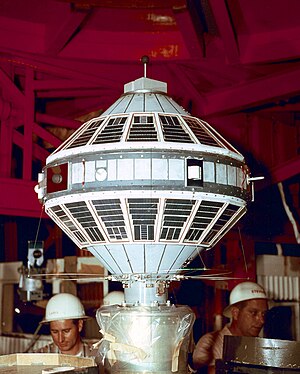 Explorer 7 satellite | |
| Names | NASA S-1A |
|---|---|
| Mission type | Earth science |
| Operator | NASA |
| Harvard designation | 1959 Iota 1 |
| COSPAR ID | 1959-009A |
| SATCAT no. | 00022 |
| Mission duration | 1 year, 10 months and 10 days (achieved) 65 years, 1 month and 11 days (in orbit) |
| Spacecraft properties | |
| Spacecraft | Explorer VII |
| Spacecraft type | Science Explorer |
| Bus | S-1A |
| Manufacturer | Jet Propulsion Laboratory |
| Launch mass | 41.5 kg (91 lb) |
| Dimensions | 76 × 76 cm (30 × 30 in) |
| Start of mission | |
| Launch date | 13 October 1959, 15:30:04 GMT[1] |
| Rocket | Juno II (AM-19A) |
| Launch site | Cape Canaveral, LC-5 |
| Contractor | Army Ballistic Missile Agency |
| Entered service | 13 October 1960 |
| End of mission | |
| Last contact | 24 August 1961 |
| Orbital parameters | |
| Reference system | Geocentric orbit[2] |
| Regime | Low Earth orbit |
| Perigee altitude | 573 km (356 mi) |
| Apogee altitude | 1,073 km (667 mi) |
| Inclination | 50.27° |
| Period | 101.38 minutes |
| Instruments | |
| Ground Based Ionospheric Heavy Primary Cosmic Rays Micrometeorite Solar X-Ray and Lyman-Alpha Radiation Thermal Radiation Trapped Radiation and Solar Protons | |
Explorer program | |
Explorer 7 was a NASA satellite launched on 13 October 1959, at 15:30:04 GMT,[1] by a Juno II launch vehicle from Cape Canaveral Air Force Station (CCAFS) to an orbit of 573 × 1,073 km (356 × 667 mi) and inclination of 50.27°.[2] It was designed to measure solar X-ray and Lyman-alpha flux, trapped energetic particles, and heavy primary cosmic rays. Secondary objectives included collecting data on micrometeoroid penetration, molecular sputtering and studying the Earth-atmosphere heat balance.[3]

- ^ a b "Launch Log". Jonathan's Space Report. 21 July 2021. Retrieved 2 November 2021.
- ^ a b "Trajectory: Explorer 7 (1959-009A)". NASA. 28 October 2021. Retrieved 2 November 2021.
 This article incorporates text from this source, which is in the public domain.
This article incorporates text from this source, which is in the public domain.
- ^ "Display: Explorer 7 (1959-009A)". NASA. 28 October 2021. Retrieved 2 November 2021.
 This article incorporates text from this source, which is in the public domain.
This article incorporates text from this source, which is in the public domain.